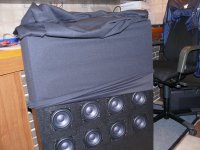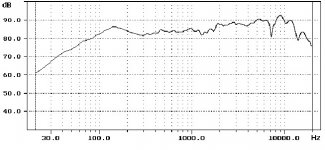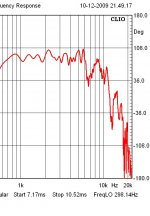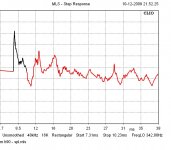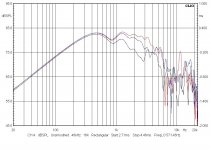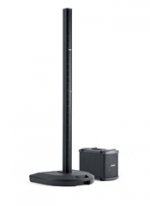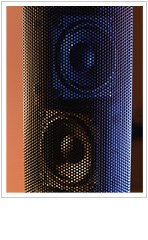sounds like a great project. How many of these things wd you need to get down to 75hz? (you see where I'm going)
They have an Fs of 140-some Hz... many will go no lower than a single one. Just take a lot more effort to make them reach xMax.
dave
I mean curved as in convex instead of focused.
convex? would mean more smear in time domain, and more reflected sound, could be interesting but rather against any acknowledged theory
on the other hand concave would result in theoretically better sound in the sweet spot, less smear in time domain, and no smear in the exact focus point but at the price of making the spot even smaller
I think that just flat baffle is a good starting point
I have found those measurements - here they are
the measured was an array of 4x4 four-inches driver, an array of comparable dimensions as would have tightly packed 10x10 array of two-inchers so smear in time domain should also be comparable
first image is the array
second is frequency response of individual driver as published by the manufacturer
third is frequency response of the array measured in axis and at the listening distance of 2.5 m
this is CLIO plot labelled "unsmoothed", the +/-2 dB wiggles are due to uneven sound wave path lenghts and interference
forth is step response of the array also measured at the listening distance of 2.5 m but it is slightly off axis (at the height of 90 cm), floor reflection can be seen I believe
those measurements wer not very professional...
anyway, an array if two-inchers certainly mean even better freq. response (less wiggles) and more extension in the highs and time response looks all right
best regards,
graaf
Attachments
forth is step response of the array also measured at the listening distance of 2.5 m but it is slightly off axis (at the height of 90 cm), floor reflection can be seen I believe
Attachments
This sounds like a really fun project. I felt mildly jealous when I read your post, something that I rarely feel when people are discussing their equipment since mine is good enough to disappoint me very infrequently.
I do like to tinker tho' and I like things that are unusual. You could wire these up in so many ways. My first impulse would be 2 x (10 x 10) and try and run them off a txformerless tube amp as graaf suggests. Just because it's there. You could try packing in natural hexagons, there's one at 91 (6 on an edge). I'd get somebody to CNC cut a baffle, but you can cut that size hole with a power drill & hole cutter.
This doesn't give you any room for signal processing, but you could rewire without too much trouble. It's not that the schemes with crossovers aren't interesting, more that you have to set a limit to the complexity somewhere, and the measurements you could take off the basic array might be a starting point to thinking about making a better system
As for building a single line, I understand the theoretical considerations that suggest this, but you could take a step into uncharted territory here, and again, you can always rebuild. At 6kHz the wavelength is ~6cm - which you could probably achieve, centre-to-centre. Above 12kHz most people don't distinguish much pitch it's more a sensation of pressure, and just how perceptible the lobing will be is anybody's guess.
The array would still be at least ~20" across, which is not small, are you going to put it in a (ported?) box and treat it as a single driver, or try OB? This is a consideration that makes a rectangular array more practical in some respects.
w
I do like to tinker tho' and I like things that are unusual. You could wire these up in so many ways. My first impulse would be 2 x (10 x 10) and try and run them off a txformerless tube amp as graaf suggests. Just because it's there. You could try packing in natural hexagons, there's one at 91 (6 on an edge). I'd get somebody to CNC cut a baffle, but you can cut that size hole with a power drill & hole cutter.
This doesn't give you any room for signal processing, but you could rewire without too much trouble. It's not that the schemes with crossovers aren't interesting, more that you have to set a limit to the complexity somewhere, and the measurements you could take off the basic array might be a starting point to thinking about making a better system
As for building a single line, I understand the theoretical considerations that suggest this, but you could take a step into uncharted territory here, and again, you can always rebuild. At 6kHz the wavelength is ~6cm - which you could probably achieve, centre-to-centre. Above 12kHz most people don't distinguish much pitch it's more a sensation of pressure, and just how perceptible the lobing will be is anybody's guess.
The array would still be at least ~20" across, which is not small, are you going to put it in a (ported?) box and treat it as a single driver, or try OB? This is a consideration that makes a rectangular array more practical in some respects.
w
Bessel Arrays.
Had to Google it. Neat stuff.
ProSoundWeb | Getting Acquainted With the Bessel Array, Page 1
Omni-directional?
I like your spirit of experimentation! One has to be a bit crazy to buy so many drivers, but I use the word "crazy" in its best sense, as I consider myself crazy sometimes when it comes to DIY speakers. I once bought 64 of those $0.69 4" fullrange drivers from PE, and still have not yet found a good use for them.
I'd suggest that you consider trying your 200 2" drivers in an omni-directional configuration, like having them distributed over a spherical enclosure directed in all directions. You will get interferences from adjacent drivers at high frequencies, but if you have enough closely spaced drivers at somewhat randomized locations (like dimples on a golf ball) perhaps the response would not be too bad looking.
I've tried the cheap 4" drivers in an omni-directional arrangement (9 drivers on a ball-ike enclosure), and the result was fairly interesting. I've also tried 18 of them in a single line array in a dipole (i.e., open baffle), and the result was also interesting. Nevertheless, I thought the omni-directional arrangement was more fun. Also, I have the B&G RD75 drivers, which are "real" line sources, and the psuedo line source with the 4" drivers simply could not compete with the RD75 driver, which is in another league in terms of clarity. I kind of came to the conclusion that it is not worth the trouble to do psuedo line sources with small cone drivers when real line sources like the B&G drivers are available.
Just my 2 cents.
Cheers,
Kurt
I like your spirit of experimentation! One has to be a bit crazy to buy so many drivers, but I use the word "crazy" in its best sense, as I consider myself crazy sometimes when it comes to DIY speakers. I once bought 64 of those $0.69 4" fullrange drivers from PE, and still have not yet found a good use for them.
I'd suggest that you consider trying your 200 2" drivers in an omni-directional configuration, like having them distributed over a spherical enclosure directed in all directions. You will get interferences from adjacent drivers at high frequencies, but if you have enough closely spaced drivers at somewhat randomized locations (like dimples on a golf ball) perhaps the response would not be too bad looking.
I've tried the cheap 4" drivers in an omni-directional arrangement (9 drivers on a ball-ike enclosure), and the result was fairly interesting. I've also tried 18 of them in a single line array in a dipole (i.e., open baffle), and the result was also interesting. Nevertheless, I thought the omni-directional arrangement was more fun. Also, I have the B&G RD75 drivers, which are "real" line sources, and the psuedo line source with the 4" drivers simply could not compete with the RD75 driver, which is in another league in terms of clarity. I kind of came to the conclusion that it is not worth the trouble to do psuedo line sources with small cone drivers when real line sources like the B&G drivers are available.
Just my 2 cents.
Cheers,
Kurt
Last edited:
constant beam
check out this paper
http://www.xlrtechs.com/dbkeele.com/PDF/Keele (2005-10 AES Preprint) - CBT Paper 5.pdf
check out this paper
http://www.xlrtechs.com/dbkeele.com/PDF/Keele (2005-10 AES Preprint) - CBT Paper 5.pdf
If your room height does not allow that, leave out few drivers.
or go bipole.
Thanx for that... i've been looking for that paper.
dave
Bessel Arrays.

what's the point of Bessel array in a home listening room? aren't they for PA or just tweeters?
Dr Jim "line array" Griffin says:
Bessel arrays have no application for an in-home line array as the array effect sums in the far field. One well known pro sound engineer has suggested a 30 times the array height listening distance for Bessel arrays which is clearly not useful for an in-home application.
(...)
Bottom line is that Bessel arrays are a dead end for use in in-home line arrays and in fact are seldom used even in pro sound applications. All of the latest pro sound line arrays operate in both the near and far fields and do not use the Bessel array configuration.
on the other hand I can show one potential and very significant advantage of flat 10x10 array - very high directivity that probably would allow to take the room out the sound equation (not in the bass area of course)
perhaps the directivity index above 500 Hz can meet even the most demanding requirements of Dr Earl Geddes but without any horn/waveguide design problems
image attached is fr of 4x4 array - red on axis, blue at 15 degrees, black at 30 degress off axis at 1 meter
best regards,
graaf
Attachments
Bose make loudspeakers that use multiple drivers.
Looking at their products might give you a few ideas.
The 802 has 8 drive units, 2 horzontal rows of 4 on a curved baffle with reflex ports,
The drivers are wired in series and the the central four drivers have an additional HF boost from a capacitor. Bose now make a novel line array speaker for stage performers the L1 has up to 24 drivers in a line array. The drivers are angled to give wider dispersion. A separate sub is used.
Looking at their products might give you a few ideas.
The 802 has 8 drive units, 2 horzontal rows of 4 on a curved baffle with reflex ports,
The drivers are wired in series and the the central four drivers have an additional HF boost from a capacitor. Bose now make a novel line array speaker for stage performers the L1 has up to 24 drivers in a line array. The drivers are angled to give wider dispersion. A separate sub is used.
Attachments
Bose make loudspeakers that use multiple drivers.
Looking at their products might give you a few ideas.
The 802 has 8 drive units, 2 horzontal rows of 4 on a curved baffle with reflex ports,
The drivers are wired in series and the the central four drivers have an additional HF boost from a capacitor. Bose now make a novel line array speaker for stage performers the L1 has up to 24 drivers in a line array. The drivers are angled to give wider dispersion. A separate sub is used.
Similar to the idea I had with the 3 columns the outer 2 angled outwards
They have an Fs of 140-some Hz... many will go no lower than a single one.
it is a matter of amount of equalization which in case of such a multidriver array is a must anyway
100x in this case mean:
1) 102.6 dB 1W/1m nominally - plenty of room for equalization
and
2) at least 94 dB @35 Hz of max SPL within linear displacement - if one needs more in his listening room than he must be a happy and rich owner of a BIG room
best regards,
graaf
Here's a thought, bit like bipole.
Picture a piece of square box-section. Along each side, put 25 2" holes. Make two of them. Might be an idea to crossover the ones that aren't firing directly at you, but I'd keep that as an option, as the added high frequency reflections would certainly give an interesting sound. It's a bit like an omnidirectional speaker, but not spherical like others have suggested.
Chris
Picture a piece of square box-section. Along each side, put 25 2" holes. Make two of them. Might be an idea to crossover the ones that aren't firing directly at you, but I'd keep that as an option, as the added high frequency reflections would certainly give an interesting sound. It's a bit like an omnidirectional speaker, but not spherical like others have suggested.
Chris
Transducer lego
Heck - what a great opportunity to experiment and get a feel for all sorts of things. "What happens if I try this?" "What if I suspend all 200 of these by strings from the ceiling, all over my listening room?"
My basic impulse here is to set up a system for working with these drivers that enables you to configure and reconfigure.
What if you mounted and wired them up into 4X1 modules on a narrow baffle/ flange, and put hook velcro around the baffle... transducer lego, here we come!
As I'm fond of saying, "If I'm not messing around, I'm wasting my time". That'll probably go on my gravestone, (if they don't burn me at the stake first).
Have fun, JF
Heck - what a great opportunity to experiment and get a feel for all sorts of things. "What happens if I try this?" "What if I suspend all 200 of these by strings from the ceiling, all over my listening room?"
My basic impulse here is to set up a system for working with these drivers that enables you to configure and reconfigure.
What if you mounted and wired them up into 4X1 modules on a narrow baffle/ flange, and put hook velcro around the baffle... transducer lego, here we come!
As I'm fond of saying, "If I'm not messing around, I'm wasting my time". That'll probably go on my gravestone, (if they don't burn me at the stake first).
Have fun, JF
Would there be any benefit to curving the 10x10 array?
reduction in polar interference and larger sweet spot.
Here's a thought, bit like bipole.
Picture a piece of square box-section. Along each side, put 25 2" holes.
Somewhat like the DBX Soundfield?
http://www.renatogiussani.it/images/Ste_Perc/pag66_1.jpg
- Status
- This old topic is closed. If you want to reopen this topic, contact a moderator using the "Report Post" button.
- Home
- Loudspeakers
- Full Range
- 200 x 2" drivers What to do?
